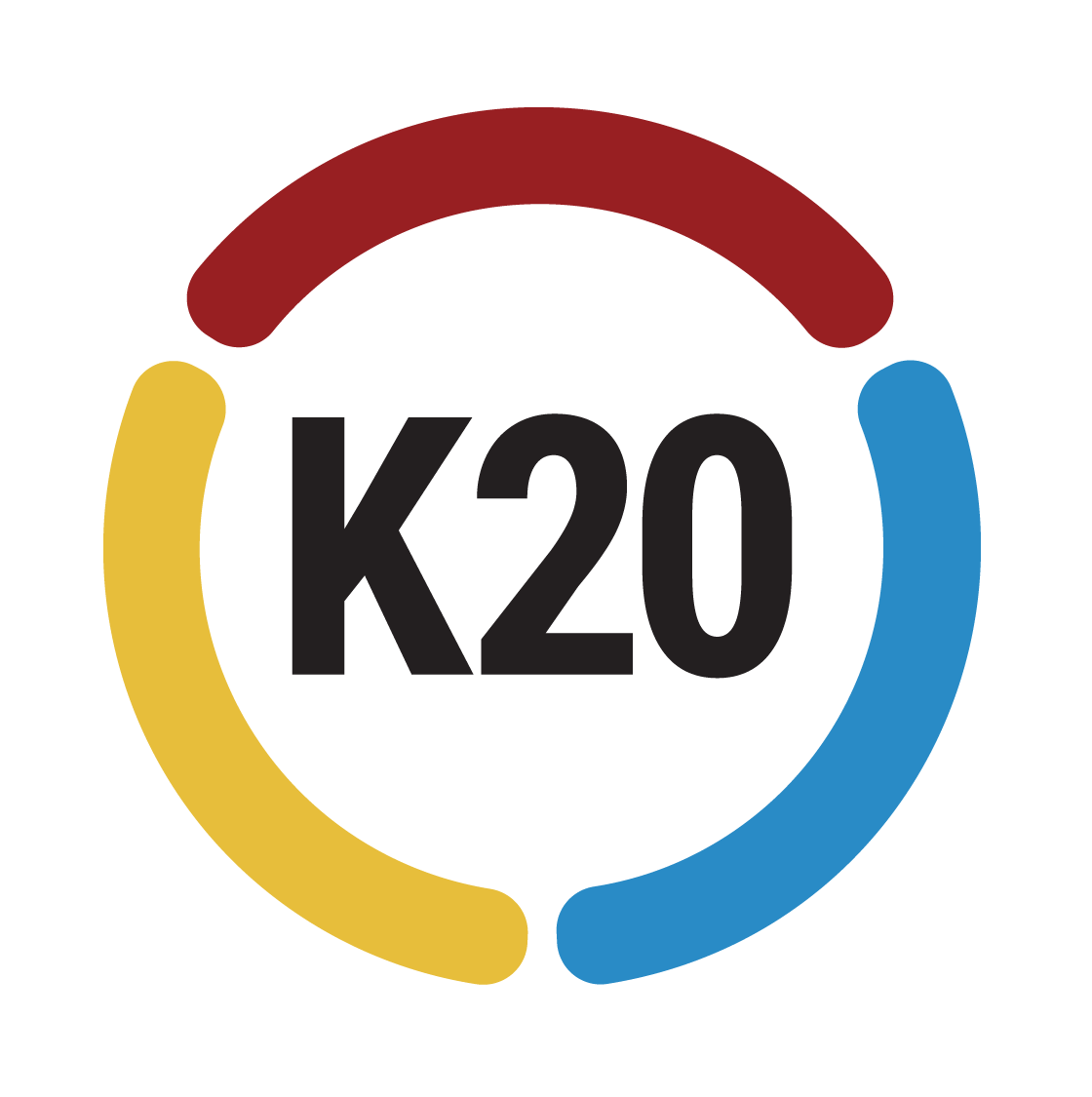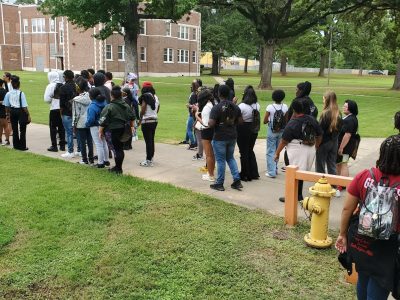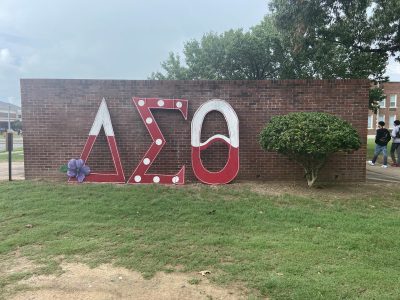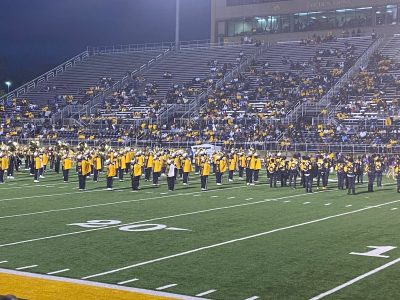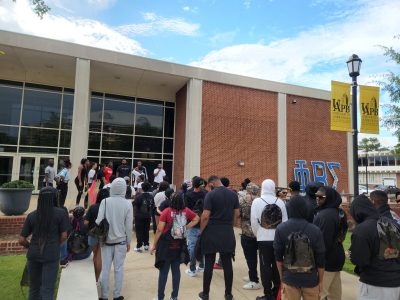Unlocking Next-Level College Visits
The GEAR UP O+K=C Team
The GEAR UP O+K=C team (Ayanna Wheeler, Mariana DeLoera, Samaya Williams, Patricia McDaniels-Gomez, and Lisa Loughlin) took one very successful college visit and helped it grow. Now, students and teachers can use the Road Trip to the Future: Exploring Minority-Serving Institutions Collection to plan their own college visits and explore the history, culture, and importance of Historically Black Colleges and Universities (HBCUs), Hispanic-Serving Institutions (HSIs), Tribal Colleges and Universities (TCUs), and Asian American and Native American Pacific Islander-Serving Institutions (AANAPISIs). We sat down with the team to learn more about their experiences.
How did this idea come about?
Ayanna Wheeler: We work with our schools on action plans every year, and this year, one of our schools expressed interest in taking their students on a college tour to an HBCU outside of Oklahoma. We wanted to connect more students to this opportunity, so we worked with them to connect them to an organization called College Campus Tours. Patricia and Mariana came up with some really cool lessons and professional development to make it more than just a campus visit. They presented their great work at an NCCEP, and now I’ll turn it over to them to share.
Mariana DeLoera: All of this came about through an action plan, which started with one specific school. We brainstormed what we could do and started with an educator resource called Road Trip to the Future, which is now a collection on LEARN. It started with exploring historically Black colleges and universities. The idea was for students to explore specific schools, learn about their historical background, famous alumni, programs offered, and to prepare some questions for the campus tour before they visit.
Patricia took these resources out to several of our schools, and the students went on the tour. It started with Douglass, then Star Spencer. Samaya and Trisha went out to the schools and they can speak on the facilitation. They did the educator resource with the students. Then the students actually went on the tour. At Douglass, they also stopped at historical sites like the Emmett Till Memorial. For that, we created a separate social studies lesson called Remembering Emmett Till, and the students talked about what they saw. Other schools got interested in these tours, so we created similar resources for Hispanic serving institutions, tribal colleges and universities, and Asian American, Native American Pacific Islander serving institutions. They’re all published on LEARN, so if schools want to expose their students to minority serving institutions, there are resources they can share with students before they go on the tour.
Ayanna Wheeler: Students just being able to explore campuses, some of which they may have heard of from family members or teachers—and being able to research before visiting the institution—was really great. We also wanted them to think through and research the different measures and programs offered there.
But what about the clubs you might want to join? The project that the team created was really helpful. It let them see not only the history of the institution, but also how students can get involved. That is a key part of this: wanting students to visit a campus where they could feel like they belong, matter, and be seen.
That was so important and has been a recurring theme at all the different schools who are taking it on this year. We just want students to have the opportunity to visit colleges in Oklahoma–or outside Oklahoma–where they might have a cultural connection that can really help them feel like they belong on that campus. We are trying to create a ton of resources for them, but also for the NCCEP conference. NCCEP was a great opportunity for GEAR UP programs across the nation to learn more about this great resource that we developed.
Samaya Williams: With NCCEP, we started out with the goal of showing and exposing other GEAR UP programs to the possibility of exposing their kids to minority-serving institutions. We started out by having them reflect and think of a time when they felt seen and heard.
I gave them a story about myself and a business me and my family run and how we are minorities–we’re double minorities in this field of dump trucking. We’re Black women. Whenever we see other people that look like us and women doing what we’re doing, it gives us courage to be able to do these things and be successful at it. That’s the same sentiment they heard from a video we showed of kids who were actually on these trips and how they said it made them feel like they were able to do this, too, when they saw people who looked like them out in a profession or on college campuses. They could feel connected. Then Patricia offered a survey to people on social media who went to HBCUs or MSIs or other minority-serving institutions on how they felt and what their experience was like.
That, coupled with some research that we’ve done, allowed participants to read people’s testimonies and hear what the research says about the benefits of exposing and connecting kids and students to institutions that they can identify with. That was a positive outcome.
Then they got to dig into the research behind it and read it. They compared a timeline to a research brief. From there, they got to experience what they would be giving their students. They looked up a school that represented their particular students and answered questions based on that. From there, they would make a pledge or write a SMART goal on an action step that they would take, considering who they could connect with in order to make this trip a reality. Some people asked, “How are you able to do this? What if we don’t have the funding?” We said, “Start with the resource on LEARN.“
Would you talk a little more about what that starting point looks like in a classroom?
Mariana DeLoera: The research project that students are doing? Each educator resource has a designated place to find the list of all the specific schools designated to that MSI. For example, the HBCU resource has a website, and the Tribal College resource has one specific to it as well. Each one has a list, and students are provided with a list of all the schools. From there, there are some teacher’s notes. For example, if you are preparing for a specific campus visit like Douglass, we narrowed it down and curated that list to look at the schools that you’re actually going on a campus tour of. If certain outside stakeholders were taking their students to a specific school, they could narrow it down by that specific school, but the entire list is published for each one. Then, students research a little bit about the history of each specific school. Many of these schools have a rich history as to how they became the designated MSI schools. After that, they are given a graphic organizer.
They have a graphic organizer to walk them through it. A lot of it starts out with basic questions: what are the admission requirements for this school? What are some specific programs in these schools that you’re interested in? The graphic organizers have a lot of basic overviews of the colleges. Then it gets more personalized, like what specific organization and or club are you interested in? Many of these institutions have a lot of really cool organizations and clubs that help students feel at home.
So students answer these questions based on their research. At the end, they have a completed graphic organizer. As an extension of this, they create Anchor Charts representing that school. For example, if they were researching Langston University, they would have all the facts they learned about Langston University on a big Anchor Chart, and it would be like a visual representation of this school. Then students do a Gallery Walk and look at all the different represented schools that we’re researching. If you are going on a campus visit, the extra extension involves preparing some questions based on this Gallery Walk to ask on the campus tour. So, for example, if I’m curious as to what programs Langston University has for first-generation students, I write that down and take that question with me. All of the guided activities follow that same structure.
After our NCCEP presentation, we actually had one of our participants reach out asking for more information regarding these resources. So it’s slowly growing, and that was the goal. I think it’s a really cool concept that we take to schools.
Samaya Williams: Which is the sentiment we told to people who asked, “How do we do this?” Start with implementing the lesson. It’s free.
Samaya Williams: Yes, anything that starts has to start with knowledge. And on the IDEALS, on equity, that is one of our objectives. How is equity being supported in higher education? And why is there a greater need for minority-serving institutions? Making it equitable is like making it accessible. It’s not accessible if you don’t really know it’s possible. Educators giving students the opportunity to look into these institutions, or research them, or do anything like that can make that ideal accessible to them–once students see it’s possible, it can be a motivating factor to want to pursue it. To go there, to see themselves here, to say, “I can do that.”
Mariana DeLoera: Some of these GEAR UP programs work differently, and like Samaya mentioned, we want to offer free resources and virtual tours for teachers who can’t realistically take their students out.
And some of these MSI schools are in these students’ communities, but they might not know a particular school is a designated MSI school or what it means to have that designation. For example, there are a lot of really big schools, like Texas A&M, that you wouldn’t imagine are designated as Hispanic-serving institutions. Huge schools. So what does that mean? It means that those schools offer federal funding for specific programs to help a designated population. Or maybe they offer access to more organizations or programs that might benefit students. So even if students or teachers don’t have a specific school in mind, or have schools that they’re already considering, they might not know certain schools have these support systems in place.
Of the schools that have taken part so far, what MSIs have they visited?
Patricia McDaniels-Gomez: It started with action plans at Douglass and then spread to other schools. Whenever we spend money for schools with these action plans, we have professional development for them. That’s where Mariana came in with making those resources for both the teachers and the kids.
After Douglass, the idea spread to Star Spencer last year. This year, we have two schools taking part: Douglass again, which is going to a different school in Texas, and US Grant, which may be going to Paul Quinn in Dallas. They’re also going to Southeast for an HSI, and John Marshall is going for HBCUs visits down in the Houston area. So it’s expanding, and not just with our grants, but also with GEAR UP for MY SUCCESS.
What do you want people to know about this? And how would they take action if they’re interested in doing an activity like this?
Lisa Loughlin: We want more people to be aware of these opportunities, especially students. They’ll never know that these things exist unless we’re actively talking about them and promoting them. That was the great thing about this action plan. It introduced students to this whole other world that they had no idea about. We want to continue to promote that and make sure that people are aware that these institutions are growing. They’re becoming more and more widely known.
Samaya Williams: We have a pledge card. It’s an intentional starting point to help teachers connect with their kids and to be culturally responsive to them. Not just superficially, but on a level of deeper culture. It’s very student-centered to cater to students that way.
Mariana DeLoera: Teachers, school administrators, counselors, GEAR UP coaches–any external stakeholder could do this. Whoever is taking it on, we want them to identify an action step they can take to expose students to MSIs.
How was it working on this activity for you personally? What connections did you have to developing this resource?
Lisa Loughlin: For me, it’s a fun resource to be part of and help develop because I believe in its purpose. It was fun to create because we could see that it is really meaningful. It can really help people, and that’s something I think we’re all passionate about doing.
Mariana DeLoera: It just felt empowering to provide some of these resources to students, and it was fun. It was a fun project. We got to learn so much about different schools and the opportunities they offer. And my team is always so fun to work with; so hey, we’ve got a good team that is also passionate about these types of projects.
Samaya Williams: I’m all about the kids. When I see an action plan like the one from Douglass–and I saw how invested the kids were–and then I hear the kids say it makes them feel like they see themselves at one of these institutions, that’s why. And that’s what it’s about.
Patricia McDaniels-Gomez: I agree. It’s empowering, you know. Seeing how well the visit was received by the Douglass students and how involved they were–it was heartwarming. I just loved it.
